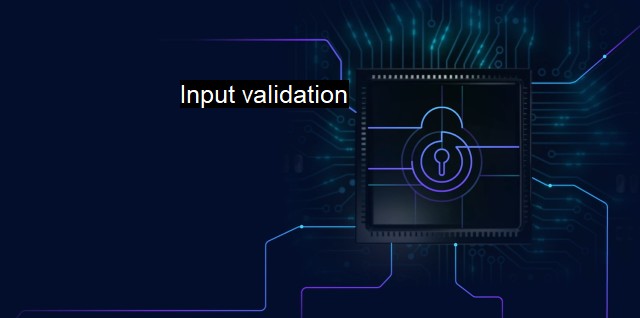What is Input validation?
The Importance of Input Validation in Cybersecurity: Safeguarding Computer Systems and Networks Against Malicious Attacks
Input validation is often discussed within the realm of cybersecurity and antivirus software due to its profound importance in securing systems and data. It is indeed a necessary safeguard for web applications, software applications, and databases. The objective of input validation is to establish programmatically that the data received by an application is as planned, correct, and harmless as possible. So, what precisely is input validation, and how does it play a pivotal role in cybersecurity?Input validation, often known as data validation, is a crucial method in which input given by users or that otherwise reaches an application is tested for accuracy, relevance, and security. From a cybersecurity standpoint, this process comprises checking whether incoming data has the proper layout, is within operational or agreeable boundaries, and does not include malicious or harmful coding. For instance, an application could be designed to agree that the input is a logically valid email address, fits within certain criteria for passwords, or does not include particular scripting elements that might lead to harmful exploitation.
Mandatory whenever data crosses a trust boundary, input validation serves as a fundamental cybersecurity technique, working on the principle that all input is untrusted unless validated. It defends systems against broad classes of vulnerabilities, such as Adobe Flash-based attacks, script injection attacks, and SQL injection attacks. These attacks typically happen when an application or database receives input that includes malicious instructions disguised as legitimate data.
A critical part of many forms of input validation is sanitizing the input, which purges or modifies any dubious characteristics in the data based on a collection of guidelines. Data sanitization plays a dual role in that it not only reduces the risk of invalid input crashing an application but also inhibits security risks by eliminating or altering potentially harmful elements.
Input validation is most effective when used in conjunction with other programming best practices, such as implementing principle of least privilege (PoLP), output processing, and error handling. Together, these techniques deepen the layer of protection provided to the system, validating the defenses, and providing security with multiple dimensions.
Anti-virus software substantially relies on this system. Cyber attackers can share complex strings of codes disguised in regular files when targeting your computer. By validating the incoming data/input, these applications are saving your data or system from being exposed to viral threats. if you download a pdf doc, the antivirus software will check the file for potential hazards before allowing you to open it.
In an ideal world, all harmful or invalid data could be successfully cleaned or censored from any incoming input. But in the practical world of cybersecurity, this isn't always possible due to complex exploits or sheer volume of incoming data that need to be examined. Thus, input validation practices allow for some potential faults or unclean data to occur. This is where the notion of "rejecting" comes into play. If an input validation process determines that it cannot safely sanitize or validate an input, the best alternative is to outright reject the data.
Input validation presents itself as a basic but pivotal cybersecurity procedure that strengthens anti-virus software's ability to safeguard user and system data. The process works by confirming the integrity, correctness, and security of incoming data—ranging from user inputs on a webpage to files downloaded from the internet—essentially acting as an early detection and prevention mechanism against potential threats. Combining input validation with other protective procedures constitutes a comprehensive strategy for helping maintain cybersecurity within our increasingly connected world.

Input validation FAQs
What is input validation in the context of cybersecurity and antivirus software?
Input validation is the process of ensuring that data inputs are clean, correct, and useful for preventing cybersecurity attacks. This involves validating inputs from various sources such as user input, external systems, and databases to prevent malware and other malicious activity.Why is input validation important for cybersecurity and antivirus software?
Input validation is crucial for reducing cybersecurity risks as it prevents attackers from exploiting security vulnerabilities in the software. Without proper input validation, attackers can modify or inject malicious code into the system, leading to data breaches, system crashes, and loss of sensitive information.What are some common input vulnerabilities that could compromise cybersecurity and antivirus software?
Some common input vulnerabilities include buffer overflows, SQL injection attacks, cross-site scripting, and file inclusion attacks. These vulnerabilities can be exploited to execute arbitrary code, access confidential data, and take control of the system.What are some best practices for input validation in cybersecurity and antivirus software?
Some best practices for input validation include validating all input data, limiting the scope of user input, using input validation libraries or frameworks, using regular expressions for pattern matching, and implementing error-handling mechanisms to prevent invalid inputs from crashing the system. Additionally, continuous monitoring and testing of input validation functionality is important to ensure the software remains secure.| | A | | | B | | | C | | | D | | | E | | | F | | | G | | | H | | | I | | | J | | | K | | | L | | | M | |
| | N | | | O | | | P | | | Q | | | R | | | S | | | T | | | U | | | V | | | W | | | X | | | Y | | | Z | |
| | 1 | | | 2 | | | 3 | | | 4 | | | 7 | | | 8 | | |||||||